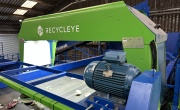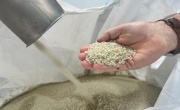Wales recycled 54.3 per cent in 2013/14
Welsh recycling rates continue to rise, as new figures released today (13 November) show that the country recycled, reused or composted 54.3 per cent in 2013/14.
The statistic, the highest annual figure that the country has ever achieved, marks a two per cent increase on 2012/13 figures, when local authorities recycled 52.3 per cent of municipal waste.
Waste statistics overview
 According to the ‘Local authority municipal waste management report for Wales, 2013-14’ figures, the total amount of local authority (LA) municipal waste (excluding abandoned vehicles) generated rose in 2013/14, from 1.54 million tonnes to 1.56 million tonnes, due to an increase in non-household waste generated.
According to the ‘Local authority municipal waste management report for Wales, 2013-14’ figures, the total amount of local authority (LA) municipal waste (excluding abandoned vehicles) generated rose in 2013/14, from 1.54 million tonnes to 1.56 million tonnes, due to an increase in non-household waste generated.
However, the amount of residual waste generated continued to fall, from 754,000 tonnes to 723,000 tonnes, with 0.6 million tonnes (38 per cent) disposed of via landfill or other methods of disposal/treatment.
The trend for using incineration as a method of disposing of waste continues to hold, with local authorities sending 25 per cent more waste to incineration with energy recovery than the year before. Indeed, six per cent of all waste generated was sent for disposal through this process.
According to the Welsh Government, this could be due to the fact that ‘particularly for waste that cannot be recycled… the use of landfill sites is discouraged in the Welsh Government waste strategy and has become more expensive for local authorities due to the landfill tax’.
Local authority break down
Denbighshire County Council led the LA table with a municipal waste reuse, recycling and composting rate of 63.2 per cent, followed by Monmouthshire County Council (62.9 per cent), Pembrokeshire County Council (60.3 per cent), and Ceredigion Country Council (58.4 per cent).
Notably, Monmouthshire, Ceredigion and Neath Port Talbot councils saw drastic increases on their year-on-year results, rising by 7.4 per cent (to 62.9 per cent), 7.2 per cent (58.4 per cent) and 5.7 per cent (to 54 per cent) respectively.
Monmouthshire and Neath Port Talbot have both reduced residual waste collections to once every two weeks, which could account for part of the increase in recycling. The rise in Neath Port Talbot could be set to increase further in 2014/15, thanks to an increase in funding. In January of this year, the Welsh Government awarded it with Collaborative Change Programme funding earlier this year in a bid to boost its recycling rates.
Ceredigion County Council’s rise in the current figures could be due to the LA entering new contracts and the start of treatment of road sweeping waste for recovery.
On the opposite end of the scale, the Isle of Anglesey, Conwy, Bridgend, Cardiff, and Merthyr Tydfil councils all saw their rates fall. Indeed, the latter reported the lowest rate of all 22 Welsh authorities, recycling, reusing or composting 48.2 per cent in 2013/14.
In all, during 2013-14, 18 of the 22 LAs in Wales met or exceeded the statutory reuse/recycling/composting target of 52 per cent.
As predicted, four LAs missed the 2012/2013 recycling target of 52 per cent: Cardiff City Council (49.7 per cent) – which had made the target last year; Rhondda Cynon Taf (49.3 per cent); Merthyr Tydfil (48.2 per cent); and Newport (51.7 per cent).
It is yet to be seen if these councils will have to pay penalties for missing the target (£200 for every tonne of waste under the target), but the Welsh Government is providing an extra £4 million of investment to Welsh councils this year to support councils that are failing to meet recycling targets by helping them develop efficient waste collection services.
Gwynedd, Swansea, Neath Port Talbot, Powys, Blaenau Gwent, and Torfaen councils all surpassed the 2012/13 target for the first time.
According to the Welsh Government, the overall rates and how they change across local authorities could be affected by ‘people’s willingness to separate waste for recycling, but also by the various collection/recycling schemes that have been introduced’, and the date on which they were introduced.
Wales is so far the only UK nation to have broken the 50 per cent recycling mark, reaching its first statutory recycling target of 52 per cent in 2012/13. The Welsh Government is now aiming for all authorities to recycle 58 per cent of waste by 2015/16, rising to 70 per cent by 2025, as part of its ‘Towards Zero Waste’ strategy.
‘An ambitious government can make improvements’

Minister for Natural Resources Carl Sargeant welcomed the statistics, saying: “Wales is the best in the UK for recycling, and local authorities and households continue to make efforts to recycle more, and send less to landfill.
“A Wales average of 54.3 per cent is a long way from 2000-01, when the rate was less than 10 per cent. It shows how an ambitious government can make improvements by working with councils and householders. We are still the only UK government that has set statutory recycling targets, and this focus is delivering results.”
Referring to his visit earlier this week to the Gofer bulking station in Conwy, Sargeant highlighted how Conwy’s Trolibocs stackable recycling box system (which was introduced following Welsh Government funding) has helped the council recycle, reuse and compost 56.3 per cent. The system is now being rolled out to all suitable households in the area.
He added: “We cannot be complacent if we are to reach our zero waste goal. In particular, I want to work with local authorities who need to make improvements to their rates.
“I am pleased to see that the amount of waste sent to landfill in Wales has continued to fall, with less than 0.6 million tonnes disposed of in this way in the last year, accounting for 38 per cent of all waste. In comparison, 92 per cent of waste was sent to landfill in 2001-02.
“We have seen an overall reduction in the waste generated, and an increase in waste sent for reuse, recycling or composting. In Wales, waste is increasingly being used as a resource.”
Read the ‘Local authority municipal waste management report for Wales, 2013-14’ report.



